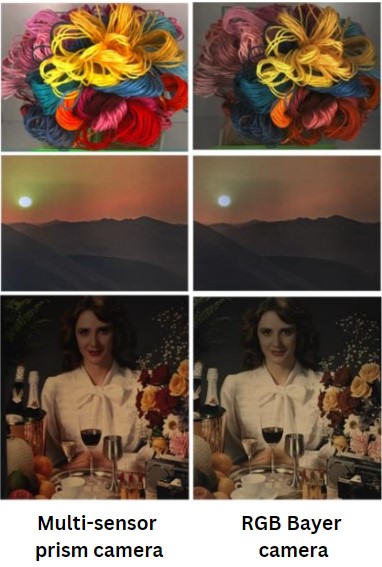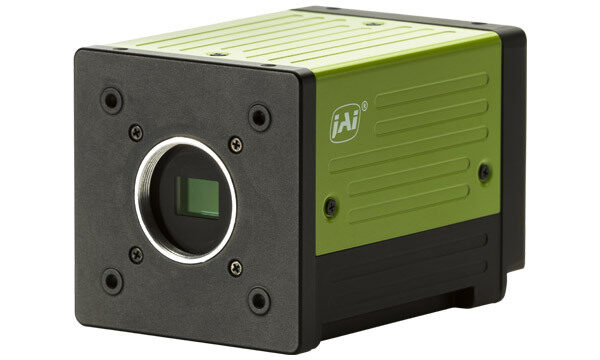|
||||||||||||||||||||||||||||||||||||||||||
|
||||||||||||||||||||||||||||||||||||||||||
JAI multi-sensor prism cameras provide a range of colour advantages over single sensor cameras
Back
to Newsletter
Go to JAI
Go to Multi-Sensor cameras
Go to Apex Series
Go to Fusion Flex-Eye Series
Go to Fusion Series
|
Multi-sensor prism-based camera technology |
||||||||||||||||||||||||||||||||||||||||||||||||||||||||||||||||||||||||||||||||||||||||||||||||||||||||||||||||||||||||||
|
Achieving true colour in terms of low inter-channel crosstalk, colour differentiation, vibrant hues, accurate contrast and good image depth for every channel can be a difficult outcome to reach. A development style that camera manufacturer JAI have pursued so to maximise their capacity to reach this outcome is through producing a large range of multi-sensor prism cameras in both area scan and line scan variants. Prism cameras separate incoming light in a way that produces much higher quality images that single sensor cameras. By contrast, cameras based on Bayer Mosaic single sensors rely on interpolation routines and so produce images that lack resolution and colour fidelity of multi-sensor cameras.
The
prism block mounted at the entry of the camera and behind the
lens is made up of multiple prisms, each with a hard dichroic
coating that separates the three RGB bands and illuminates each
sensor with a single band. The blue band (shortest wavelength)
is reflected within the prism in one direction, followed by the
red band in the opposite direction with the green passing directly
through the prism. This design method ensures minimum loss of
signal strength. Every pixel on each sensor is illuminated by
a single band. The prism also has an IR cut-off filter on its
front face to eliminate NIR wavelengths which would otherwise
provide an artefact signal on the blue and green sensors. In contrast,
a single sensor Bayer RGB camera, has filters on each individual
pixel that differ. Each cluster of full pixels has a repeating
pattern of filters over the full sensor. One pixel with red, one
pixel with blue and two pixels with green filters.
By
using multi-sensor prism based sensor designs, JAI's prism cameras
produce better colour images compared to that of standard single
sensor cameras. In order to achieve pixel-to-pixel correlation
in all bands the design and manufacture of prism based cameras
requires extreme mechanical precision that can only be achieved
with customized very high performance automation. JAI has invested
heavily for many years in this technology and is a clear leader
in producing prism cameras for the machine vision industry. There
are few other manufacturers that have committed and can produce
prism cameras. JAI's clever design allows users access to outstanding
results when it comes to image analysis and processing in colour
for machine vision applications. |
||||||||||||||||||||||||||||||||||||||||||||||||||||||||||||||||||||||||||||||||||||||||||||||||||||||||||||||||||||||||||
|
Applications
best suited to multi-sensor dichroic prism cameras:
|
 |
|||||||||||||||||||||||||||||||||||||||||||||||||||||||||||||||||||||||||||||||||||||||||||||||||||||||||||||||||||||||||
|
Fruit
and vegetable inspection/sorting systems:
A multi sensor dichroic prism camera with RGB plus NIR data is perfectly suited to fruit and vegetable inspection systems due to its high spatial detail and precise spatial fusion. RGB + NIR Prism cameras are extremely useful when identifying ripeness and defects. Since nearly all fruit and vegetable inspection systems involve some form of conveyance or vehicle movement, a prism camera with instantaneous multi-waveband capture and global shutter sensors remove all motion related artefacts. |
||||||||||||||||||||||||||||||||||||||||||||||||||||||||||||||||||||||||||||||||||||||||||||||||||||||||||||||||||||||||||
|
Intelligent
farming:
Intelligent farming systems typically operate when mounted to a continuously moving vehicle. Dichroic prism cameras with global shutter and the capability of short exposure-times remove problems with motion and vibration associated with agricultural vehicles in motion. |
||||||||||||||||||||||||||||||||||||||||||||||||||||||||||||||||||||||||||||||||||||||||||||||||||||||||||||||||||||||||||
|
Other
applications include:
• Crop health, environmental applications • Surgical guidance, life sciences, forensics • Electronics, recycling, scientific research • Meat and poultry inspection • Inspection of fruits, vegetables, nuts, grains, tea leaves • Pharmaceuticals, cosmetics, packaging • Currency inspection, passports, biometrics • Fish farming |
||||||||||||||||||||||||||||||||||||||||||||||||||||||||||||||||||||||||||||||||||||||||||||||||||||||||||||||||||||||||||
|
JAI
prism based Area Scan camera families:
|
||||||||||||||||||||||||||||||||||||||||||||||||||||||||||||||||||||||||||||||||||||||||||||||||||||||||||||||||||||||||||
|
JAI
Fusion Series
|
||||||||||||||||||||||||||||||||||||||||||||||||||||||||||||||||||||||||||||||||||||||||||||||||||||||||||||||||||||||||||
|
The JAI fusion
series is a consists of eight high-end multi-sensor prism cameras
that offer two or three colour and/or NIR bands with precise pixel-to-pixel
alignment. To ensure a consistent signal-to-noise ratio the JAI
fusion series has the ability to adjust the exposure time of each
channel. |
||||||||||||||||||||||||||||||||||||||||||||||||||||||||||||||||||||||||||||||||||||||||||||||||||||||||||||||||||||||||||
|
JAI
Apex Series
|
||||||||||||||||||||||||||||||||||||||||||||||||||||||||||||||||||||||||||||||||||||||||||||||||||||||||||||||||||||||||||
|
The
Apex series of cameras provides precise RGB raw image data which
is perfect for colour machine vision applications across a range
of industries like pharmaceutical, electronics, printing/packaging
and imaging in microscopy and medical diagnostics equipment.
The 3-sensor imaging technique used in the Apex series allows more accurate per-pixel colour values than what is possible with the Bayer Mosaic technique. The cameras also offer higher spatial resolution, enabling more accurate edge detection and the ability to resolve smaller details. The CMOS cameras
in the Apex Series deliver significant user advantages in terms
of resolution, speed and colour pre-processing functions without
being a budget-breaker. |
||||||||||||||||||||||||||||||||||||||||||||||||||||||||||||||||||||||||||||||||||||||||||||||||||||||||||||||||||||||||||
|
||||||||||||||||||||||||||||||||||||||||||||||||||||||||||||||||||||||||||||||||||||||||||||||||||||||||||||||||||||||||||
|
If you like this page, please recommend and share it. |
|||
| More | |||






 Features:
Features: Features:
Features: